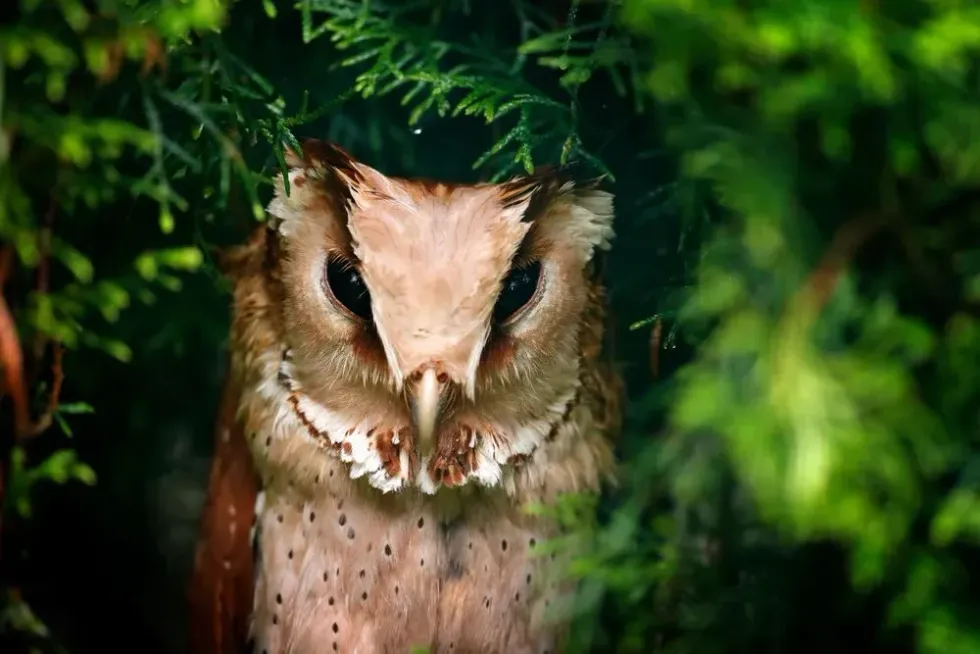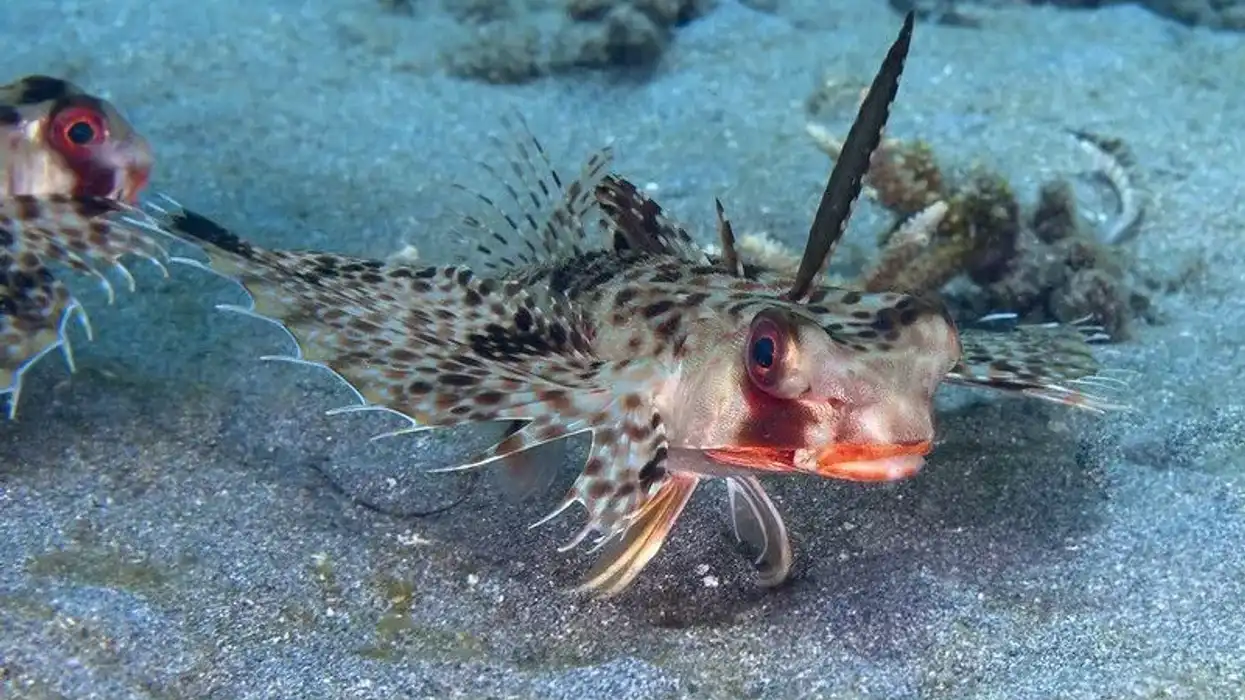The Oriental bay owl (Phodilus badius), also commonly known as the Asian bay owl, is a unique owl species native to south and southeast Asia. They are particularly found in the range of north-east India, south-east China, Indonesia, Vietnam, Myanmar, Laos, Thailand, Sri Lanka, the Malay Peninsula, and the Greater Sunda Islands.
They live in the tree hollows of deciduous and evergreen forests, mangrove forests, and other plantations in foothill regions.
The average length of an Oriental bay owl is 9-11.4 in (23-29 cm), which is relatively small in contrast to other owl species. This bird is pale chestnut brown in color with dark brown spots scattered on its underparts, along with deep chestnut brown colored wings.
The diet of these nocturnal predators includes small mammals, small birds, small reptiles, and insects.
Thankfully, the conservation status of this fascinating bird is currently Least Concern, according to the International Union for Conservation of Nature (IUCN) Red List. Due to their wide range, this species has a steady population and is not threatened.
Did you enjoy learning more about this intriguing bird? If that is the case, keep reading for more fascinating Oriental bay owl information, facts, and details. If you like this article, do read our other articles on the Nicobar pigeon and the horned lark.
Oriental Bay Owl Interesting Facts
What type of animal is an Oriental bay owl?
The Oriental bay owl (Phodilus badius) is a bird species that belongs to the Tytonidae family.
What class of animal does an Oriental bay owl belong to?
The Oriental bay owl (Phodilus badius) belongs to the Aves class and the Strigiformes order. This bird is also recognized as the Asian bay owl.
How many Oriental bay owls are there in the world?
The exact population of the Oriental bay owl (Phodilus badius) has not been determined yet. However, there are many subspecies distributed across south and south-east Asia, with the population being quite stable.
Where does an Oriental bay owl live?
The Oriental bay owl (Phodilus badius) has many subspecies that thrive throughout south and south-east Asia.
The subspecies P. b. badius is found in the range of Malaysia, south of Thailand, south of Myanmar, and the Greater Sunda Islands in Indonesia, while the subspecies P. b. arixuthus is found in the Middle Natuna Islands of Indonesia.
On the other hand, the subspecies P. b. parvus is found in the Belitung Islands of Indonesia and the subspecies P. b. saturatus is spotted in northeast India, southern China, Myanmar, Vietnam, Cambodia, Thailand, and Laos.
What is an Oriental bay owl's habitat?
The Oriental bay owl (Phodilus badius) prefers to live in the holes of trees at a height of 6.6-16.4 ft (2-5 m) in deciduous and evergreen forests, mangrove forests, and other plantations in foothill regions.
This bird can be found in cultivated areas, like dense woods between rice fields, as well as in fruit plantations on the edge of the forest.
Who does Oriental bay owl live with?
Oriental bay owls, like all other owl species, are solitary in nature. They perch on a tree branch during the day and hunt at night because they are a nocturnal species. However, they can be seen together during the mating season.
How long does an Oriental bay owl live?
The exact lifespan of an Oriental bay owl (Phodilus badius) has not been determined yet. However, other owl species live for an average of nine to 10 years in the wild and up to 25 years in captivity. Their lifespan in the wild is lower than that of the whiskered screech owl.
How do they reproduce?
The breeding habits of an Oriental bay owl (Phodilus badius) peak in the months of March to May in northeast India and Nepal. this breeding season is extended until July in Java and in other Indonesian islands, it ranges from October to December.
After mating, these carnivorous birds seek out tree hollows or cavities to build their nests in, where the female bird lays between three and five eggs in two days. The female owl is solely responsible for the incubation of these eggs, which lasts roughly around 36-42 days.
The male is in charge of collecting food.
After the owlets are born, both parents protect them diligently and feed them with lizards, frogs, insects, and mice. During the breeding season, owls become more territorial and will fiercely guard their territory to protect their partner and their young from predators.
What is their conservation status?
According to the International Union for Conservation of Nature (IUCN) Red List, the conservation status of an Oriental bay owl (Phodilus badius) is currently Least Concern. This bird species has a stable population due to its vast range and does not face any major threats.
Oriental Bay Owl Fun Facts
What does an Oriental bay owl look like?
An Oriental bay owl (Phodilus badius) is relatively small in size in contrast to other owl species. This bird has an elongated and whitish-colored heart-shaped facial disc.
The most distinguishing characteristic or feature of this bird is a faded brown V-shaped marking between its eyes that continues from the middle of its face up to its crown, giving the impression of a triangular forehead.
The plumage of this bird is pale chestnut brown with dark brown spots scattered underneath. It has a rufous short tail with deep bars and small rounded deep chestnut brown colored wings.
The eyes of this bird are dark brown, and its bill is cream in color. It has small, tufted ears that protrude slightly from the edge of its wide head.

How cute are they?
The Oriental bay owl (Phodilus badius) looks adorable because of its soft and fluffy chestnut-brown plumage and cream-colored throat. When perched on a tree branch, this bird appears to be very serene and can easily attract your attention.
How do they communicate?
The Oriental bay owl (Phodilus badius) communicates with other owls in its habitat by making repeated loud hoots or whistles. At first, during the evening, the call starts at a low and melancholic pitch, but the volume slowly increases through the night.
During the mating season, the call of this bird becomes louder. Owls mainly hoot to safeguard their territories from predators.
How big is an Oriental bay owl?
The length of an Oriental bay owl (Phodilus badius) is 9-11.4 in (23-29 cm), which is almost twice the size of a lark sparrow.
How fast can an Oriental bay owl fly?
There isn't much information about the speed of an Oriental bay owl (Phodilus badius). On the other hand, barn owls have an average speed of 10-20 mph (16.1-32.2 kph), so the Oriental bay owl's speed may be somewhere within this range.
How much does an Oriental bay owl weigh?
An Oriental bay owl (Phodilus badius) weighs approximately 9-10.9 oz (255-308 g). Females are slightly bigger in size in contrast to males.
What are the male and female names of the species?
There are no specific labels for the male and female Oriental bay owls.
What would you call a baby Oriental bay owl?
Like all other owl species, a baby Oriental bay owl (Phodilus badius) is called an owlet.
What do they eat?
The diet of these predators consists of small rodents like rats and mice, birds, frogs, lizards, and large insects like beetles. These birds attack their prey from a perch, swooping through thickets of trees beneath the canopy of the forest, using their short, rounded wings.
Are they poisonous?
No, the Oriental bay owl (Phodilus badius) is not known to have any venom and is therefore not a threat to humans. Although, if you try to enter their territory or hurt their offspring, they may turn violent and attack you.
Would they make a good pet?
No, the Oriental bay owl (Phodilus badius) is a bird of prey who thrives well in the wild and therefore should not be domesticated.
Did you know...
The highest elevation at which these owls are recorded is around 7500 ft (2286 m)!
Surprisingly, this bird prefers hunting near bodies of water.
This bird is not vigilant while roosting, and on top of that, they roost just at a mere 6.5-16.4 ft (2-5 m) height. Therefore, they are quite approachable, and if you can silently click their picture at the right time, it can be a golden shot!
However, you will need to be really careful not to make a sound, as that might disturb the innocent bird.
Oriental bay owls were misidentified as Conga bay owls for a long time due to a lack of research on the species.
How high can they fly?
The exact height at which these birds can fly is unknown. However, they attack from a high perch due to their preying habits, swooping through thick rows of trees beneath the cover of the forest to catch prey.
Are they predators?
Yes, Oriental bay owls, like all other owl species in the world, are predatory birds who prey on small mammals, small birds, small reptiles, and insects like grasshoppers.
Here at Kidadl, we have carefully created lots of interesting family-friendly animal facts for everyone to discover! For more relatable content, check out these Fischer's lovebird facts and Blackburnian warbler facts for kids.
You can even occupy yourself at home by coloring in one of our free printable oriental bay owl coloring pages.









